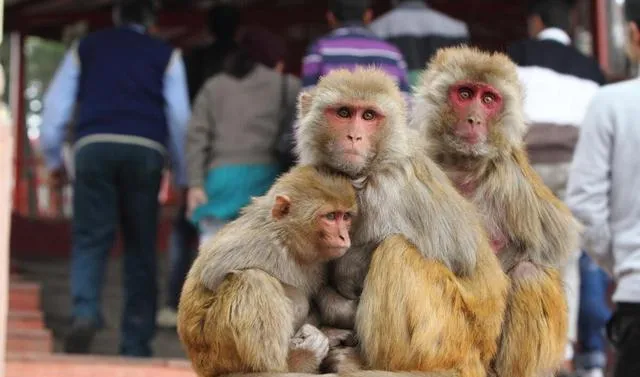Nature丨News丨Miryam Naddaf
16 Jan. 2024丨820words丨★★★☆☆
Cloned rhesus monkey lives to adulthood for first time
克隆猕猴首次活到成年
A method that provides cloned embryos with a healthy placenta could pave the way for more research involving the primates.
一种为克隆胚胎提供健康胎盘的方法可为更多涉及灵长类动物的研究铺平道路。
Getty Image
For the first time, a rhesus monkey ( Macaca mulatta ) cloned in the laboratory has lived into adulthood — surviving for more than two years so far.
实验室克隆的猕猴(恒河猴[一种猕猴,多用于实验])第一次活到了成年——迄今已存活两年多。
猕猴(恒河猴)的成年阶段 一般指雌性个体在4到5岁之间,而雄性个体则在5到6岁之间。这是它们达到生殖成熟并具备完全成熟的身体和行为特征的阶段。
The feat, described today in Nature Communications [1], marks the first successful cloning of the species, and was achieved using a slightly different approach to the conventional cloning technique used to clone Dolly the sheep and other mammals, including long-tailed macaques ( Macaca fascicularis ), which were the first primates to be cloned.
今天发表在【自然通讯】上的这一壮举标志着该物种的首次成功克隆,它采用的方法与用于克隆羊「多利」和其他哺乳动物(包括长尾猕猴)的传统克隆技术略有不同,先前,长尾猕猴是第一种被克隆的灵长类动物。
By replacing the placenta of the cloned embryo with a placenta from embryos produced by in-vitro fertilisation, scientists were able to reduce developmental defects that often hinder the survival of cloned embryos, while using fewer embryos and surrogate mothers. The new technique could unlock possibilities for using cloned primates in drug testing and behavioural research.
通过用体外受精产生的胚胎胎盘替代克隆胚胎的胎盘,科学家们能够减少经常阻碍克隆胚胎存活的发育缺陷,同时使用更少的胚胎和代孕母亲。这项新技术将为利用克隆灵长类动物进行药物测试和行为研究提供可能。
「We can produce a large number of genetically uniform monkeys that can be used for drug efficacy tests,」 says Mu-ming Poo, director of the Institute of Neuroscience in the Chinese Academy of Sciences in Shanghai.
中国科学院上海神经科学研究所所长蒲慕明说:"我们可以培育出大量基因一致的猴子,用于药物疗效测试。

Low survival rate
The standard cloning technique known as somatic cell nuclear transfer (SCNT) — where the nucleus of a body cell is transferred into an egg cell whose nucleus has been removed — typically results in extremely low birth and survival rates for cloned embryos.Success in primates has been particularly limited.
存活率低
体细胞核移植(SCNT)是一种标准的克隆技术,即把体细胞核移植到去除了细胞核的卵细胞中,这种技术通常导致克隆胚胎的出生率和存活率极低。在灵长类动物中,成功率尤其有限。
When researchers cloned long-tailed macaques in 2018, they created 109 cloned embryos, and implanted nearly three-quarters of them into 21 surrogate monkeys which resulted in six pregnancies. Just two of the monkeys survived birth.
研究人员在2018年克隆长尾猕猴时,创造了109个克隆胚胎,并将其中近四分之三植入21只代孕猴体内,结果有6只猴子怀孕。其中只有2只猴子存活下来。
In 2022, researchers cloned a rhesus monkey using SCNT, but the animal survived for less than 12 hours[2].
2022 年,研究人员利用 SCNT技术克隆了一只猕猴,但该动物存活不到 12 小时。
To investigate what goes wrong in the cloning process, researchers at the Chinese Academy of Sciences in Shanghai compared 484 SCNT rhesus embryos with 499 embryos produced by conventional in-vitro fertilisation. The two types of embryos showed similar development before they were implanted into surrogates. But the number of cloned embryos that were successfully implanted was around half that of IVF embryos (35 vs. 74), and fewer cloned embryos survived to term.
为了研究克隆过程中的问题所在,上海中国科学院的研究人员将 484 个 SCNT 猕猴胚胎与 499 个常规体外受精产生的胚胎进行了比较。两种胚胎在植入代孕母猴体内前的发育情况相似。但成功植入的克隆胚胎数量约为体外受精胚胎的一半(35 vs. 74),而且存活至出生的克隆胚胎数量较少。
The researchers ran a series of DNA analyses of SCNT embryos and found significant differences in epigenetic modification during development — structural changes that impact gene activity without altering the DNA sequence. This included reduced DNA methylation, a process that affects genes expression. 「If you have different methylation, then the gene expression during development is different,」 explains Poo. 「That’s why cloned embryo does not develop well.」
研究人员对 SCNT 胚胎进行了一系列 DNA 分析发现:发育过程中的表观遗传修饰存在显著差异,即在不改变 DNA 序列的情况下影响基因活性的结构变化。这包括 DNA 甲基化的减少,这是一个影响基因表达的过程。蒲慕明解释说:"如果甲基化程度不同,那么基因在发育过程中的表达就会不同。这就是为什么克隆胚胎发育不良的原因"。
The researchers also found that genes which are normally expressed differently between maternal and paternal genomes, lost their distinct patterns in cloned embryos, especially in cells within the placenta. Furthermore, the placentas that developed for SCNT embryos appeared to be thicker than normal and contained defects.
研究人员还发现,在克隆胚胎中,母基因组和父基因组通常以不同方式表达的基因失去了其独特的模式,尤其是在胎盘内的细胞中。此外,SCNT 胚胎发育出的胎盘似乎比正常胎盘厚,而且存在缺陷。
To address this, the researchers developed a technique that involved replacing the SCNT trophoblast — the outer layer of cells in a developing embryo, which later forms the major part of the placenta — with trophoblasts from IVF embryos. This meant the embryos developed a 「natural placenta」, says study coauthor Zhen Liu, a neuroscientist at the Chinese Academy of Sciences, 「but the fetus is still cloned fetus」.
为了解决这个问题,研究人员开发了一种技术,即用体外受精胚胎的滋养层(胚胎发育过程中的外层细胞,后来形成胎盘的主要部分)替代体细胞核移植的滋养层。这项研究的共同作者、中国科学院神经科学家刘震说:"这意味着胚胎会发育出一个'自然胎盘',但胎儿仍然是克隆胎儿"。

One healthy clone
Using this approach, the researchers created 113 cloned rhesus monkey embryos and implanted 11 of them into seven surrogates which resulted in two pregnancies.
一个健康的克隆体
通过这种方法,研究人员创造了 113 个克隆猕猴胚胎,并将其中 11 个植入 7 只代孕母猴体内,最终导致两只代孕母猴怀孕成功。
One of the pregnant surrogates gave birth to a healthy male rhesus monkey named ReTro, which has survived for more than two years. (The other surrogate carried twins, which died on day 106 of gestation).
其中一只代孕母猴顺利分娩出了一只健康的克隆雄性猕猴,取名 ReTro,它已经存活了两年多。(另一只代孕母猴怀的是一对双胞胎,在妊娠第 106 天死亡了)。
The researchers showed that incorporating the trophoblast replacement into SCNT clones reduced defects in the placenta and in DNA methylation. But 「the efficiency of the process is similar, even lower」, than SCNT, said Lluís Montoliu, a geneticist at the Spanish National Center for Biotechnology in Madrid, in a statement to the UK Science Media Centre. 「It is extremely difficult to succeed with these experiments, with such low efficiencies,」 he added.
研究人员发现,将滋养层细胞置换技术应用于SCNT克隆中,可减少胎盘缺陷和DNA甲基化问题。但是,马德里西班牙国家生物技术中心的遗传学家路易斯-蒙托柳(Lluís Montoliu)在向英国科学媒体中心发表的一份声明中表示,"这一过程的效率与SCNT相似,甚至更低"。他补充说:"在效率如此低的情况下,这些实验很难取得成功。
Since the first primate was cloned six years ago, scientists have used cloned monkeys to model diseases such as depression and anxiety[3], and to assess the efficacy and safety of drugs, including antidepressants.
自从六年前克隆出第一只灵长类动物以来,科学家们已经利用克隆猴建立了抑郁症和焦虑症等疾病的模型 ,并评估了包括抗抑郁药在内的药物的疗效和安全性。
「We're seeing the beginning of the use of these cloned monkeys now,」 says Poo. 「We want to use as few animals as possible to show drug efficacy, without the interference of genetic background.」 But he adds that with current technology, the process of producing clones still involves too many surrogates. Even with recent advances, 「we have not solved the efficiency of cloning」, he says.
蒲慕明教授说:「我们现在已经开始使用这些克隆猴了,我们希望在不受遗传背景干扰的情况下,使用尽可能少的动物来展示药物疗效」。但他补充说,就目前的技术而言,生产克隆猴的过程仍然涉及到太多的代用品。即使最近取得了进步,"我们也没有解决克隆的效率问题"。
doi: https://doi.org/10.1038/d41586-024-00136-2
References
- Zhaodi, L. et al. Nat. Commun. 15:5 https://doi.org/10.1038/s41467-023-43985-7 (2024).
- Kang, Y. et al. Sci. Adv. 8, eabo3123 https://www.science.org/doi/10.1126/sciadv.abo3123 (2022).
- Qiu, P. et al. National Science Review 6 (1), 87 https://doi.org/10.1093/nsr/nwz002 (2019).
英文取自Nature【自然】官网,翻译&精读内容归本人所有,转载请注明出处,违者必究!更多内容,请前往官网学习。
原文地址:303 See Other











